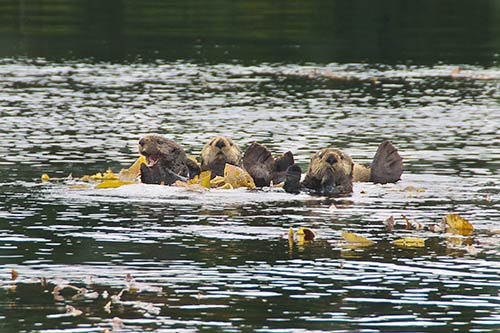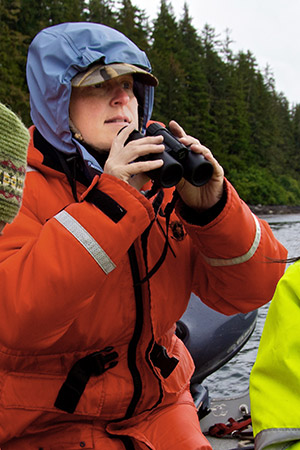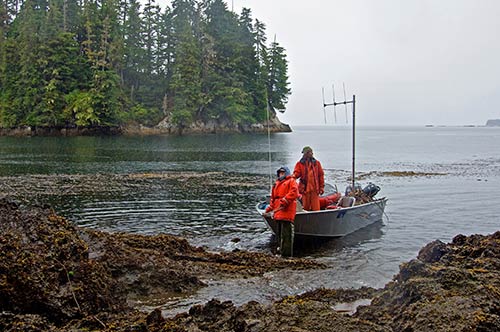
Burgeoning sea otter population in southern Southeast Alaska depletes commercial fishery speciesBy LAUREN FRISCH
January 26, 2016
In southern Southeast Alaska, commercial fisheries for these invertebrate species provide income for local economies. At the same time, a growing population of sea otters is consuming the invertebrates. Predation from the otters is already having an economic impact on commercial fisheries, and the effect is likely to be even greater as the sea otter population continues to increase.
Sea otters feeding in Tokeen Bay near Prince of Wales Island.
Sea otters were depleted in the 18th and 19th centuries as a result of abundant fur trading. In the 1960s approximately 400 sea otters were reintroduced in Southeast Alaska. The population has grown rapidly since to approximately 25,000 sea otters in 2012. Since the 2000s, fishermen have reported declines in invertebrate fisheries, spurring researchers to gather scientific information on the impacts.
While working as a dive biologist for the Alaska Department of Fish and Game in the mid-2000s, Hoyt noticed changes as sea otters began to colonize the outer coast of Southeast Alaska. “There was a lot of observational and anecdotal evidence that sea otters were seriously impacting some of the commercial invertebrate fisheries in Southeast Alaska,” said Hoyt. He decided to pursue a PhD in fisheries at UAF to study this question in depth. Hoyt’s research project had three components: mapping the correlation between sea otter distribution and reductions in fisheries, monitoring sea otter diets to determine if they are eating commercial species and tracking sea otter distribution and ranges to determine how they may be changing as populations increase. Hoyt focused the study in southern Southeast Alaska where the majority of Southeast Alaska’s commercial fisheries are located. Geoduck, sea cucumber and Dungeness crab fisheries contribute about $15–$20 million annually to Alaska’s economy. While red sea urchins are less economically valuable, urchins are a preferred food source by sea otters when available and predation can have a substantial impact on urchin populations. Initially, Hoyt overlaid past data on numbers of commercial fishery with sea otter surveys to look for a correlation between sea otter distribution and possible predation on commercial fisheries. “Where the otters had colonized, commercial fisheries were diminished or reduced to unmanageable levels,” Hoyt said. “It appeared that timing of otter colonization and reduced biomass were correlated.” Statistical analyses between interactions of sea otters and Dungeness crab, red sea urchin and geoduck clam fisheries confirmed the trends. “The next step was to look at the otters to see if they were actually consuming these commercial species, and in what quantity,” Hoyt said. During the summers of 2010 through 2014, Hoyt and a field crew used high-powered telescopes to study what the otters were eating. The researchers made approximately 7000 observations at 200 sampling locations to gather foraging information. They found that 46 percent of sea otter food was coming from commercial species. Sea otters like efficient food. Red sea urchins are preferred because they are easy to find, easy to pull apart and rich in calories. Hoyt’s team also found that Dungeness crabs are a preferred food source. Geoducks, which are large clams, can be harder for otters to extract, but the effort is worthwhile because they are energetically valuable.
Zac Hoyt and Sunny Rice return from a field day monitoring sea otters.
The tracking experiment began in 2010. Initially—as the researchers predicted—otter ranges in Frederick Sound were expanding. However, an increase in subsistence hunting in November 2012 began to alter sea otter distribution. In a population of approximately 2500 otters in Frederick Sound, annual subsistence hunting of sea otters rose from 9 otters per year to over 150 otters per year. Thirteen percent of the tracked otters were hunted during the study. The hunting spooked the otters, causing them to retract in their range and move away from centers of hunting. Hoyt believes the results of this tracking experiment would have been substantially different had the mass hunting not occurred. Hoyt’s research will provide a baseline understanding of sea otter dynamics in southern Southeast Alaska. “Now we know quite a bit about diet, movement, distribution, what species they use and don’t use, and other preliminary information,” he said. “The next step would be to look at the indirect effects of otters, positive or negative, on the ecosystem.” The main sources of funding for the project were Alaska Sea Grant and the North Pacific Research Board. The Southeast Alaska Regional Dive Fishermen’s Association, Petersburg Vessel Owners Association, Petersburg Marine Mammal Center and other fishing and mammal groups also contributed to the research. A number of other collaborators provided non-monetary support. Hoyt received his PhD from UAF in December 2015.
Provided as a public service by Alaska Sea Grant, a statewide marine research, education, and outreach program, and in partnership between the University of Alaska Fairbanks and the National Atmospheric and Oceanographic Administration.
|
|||


